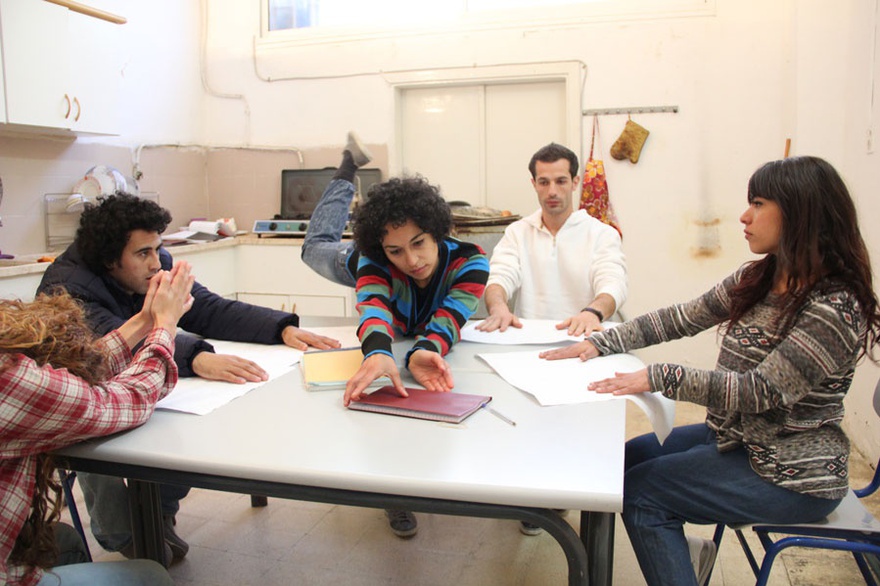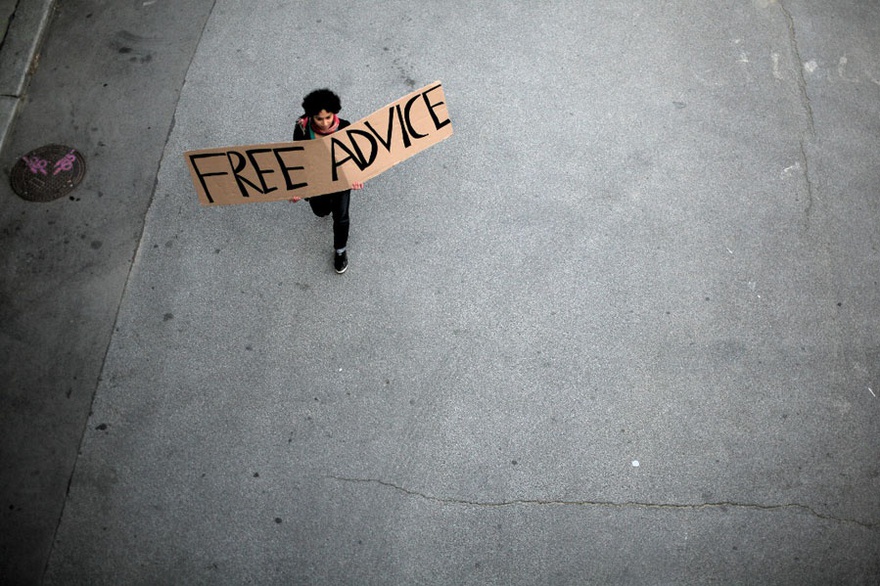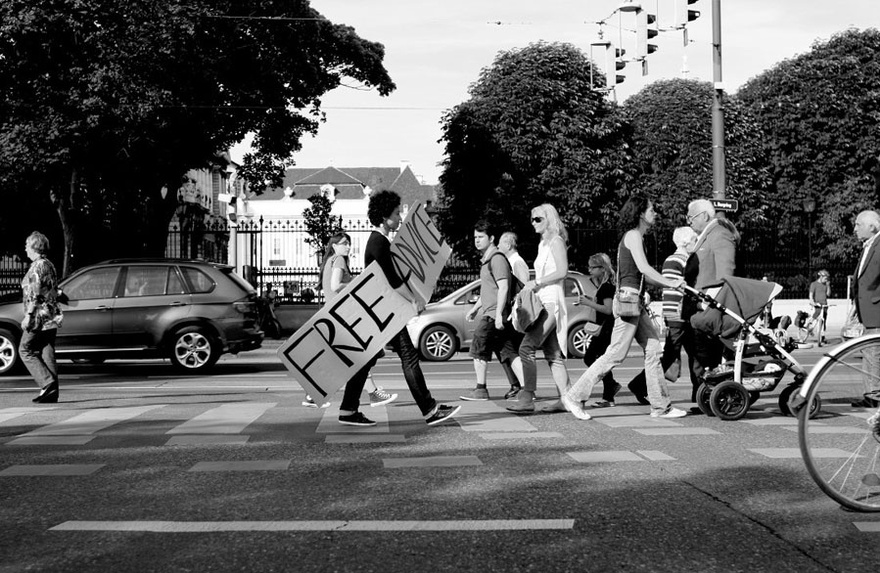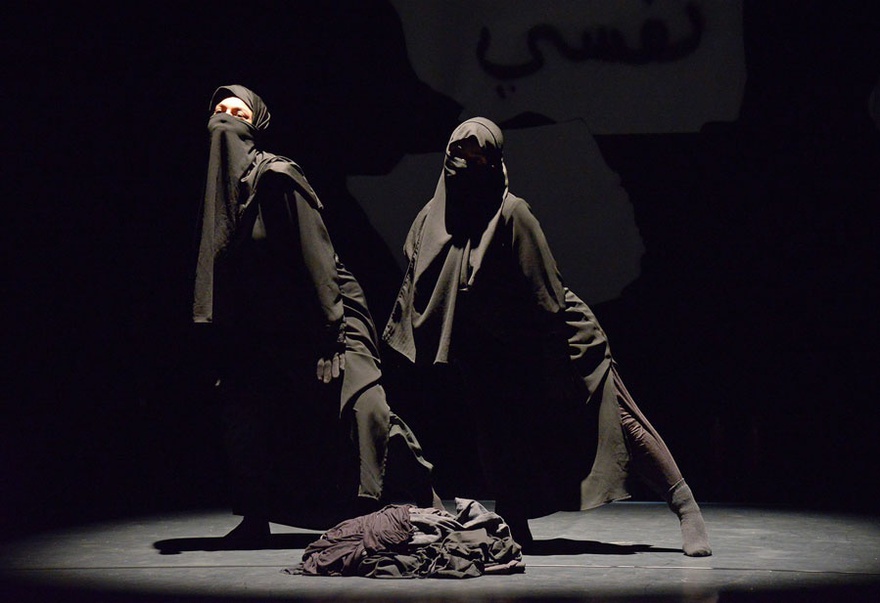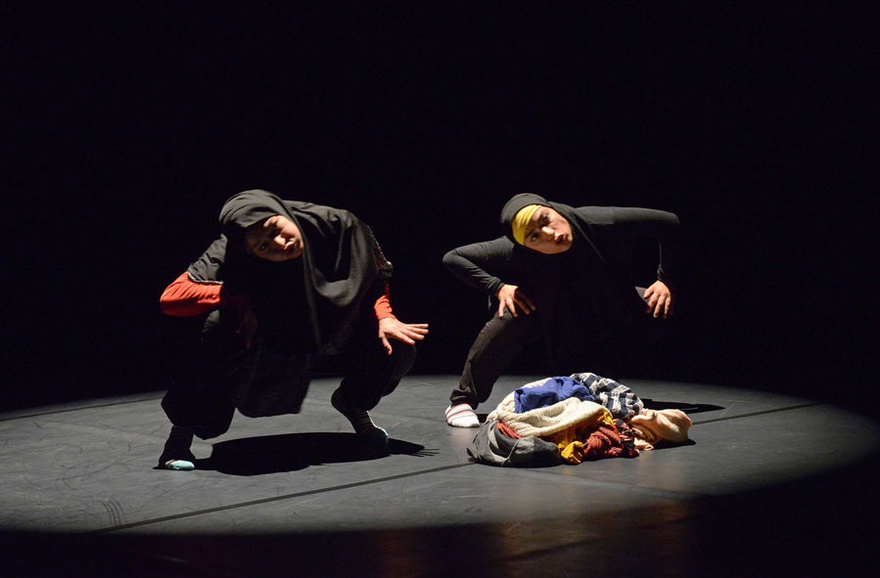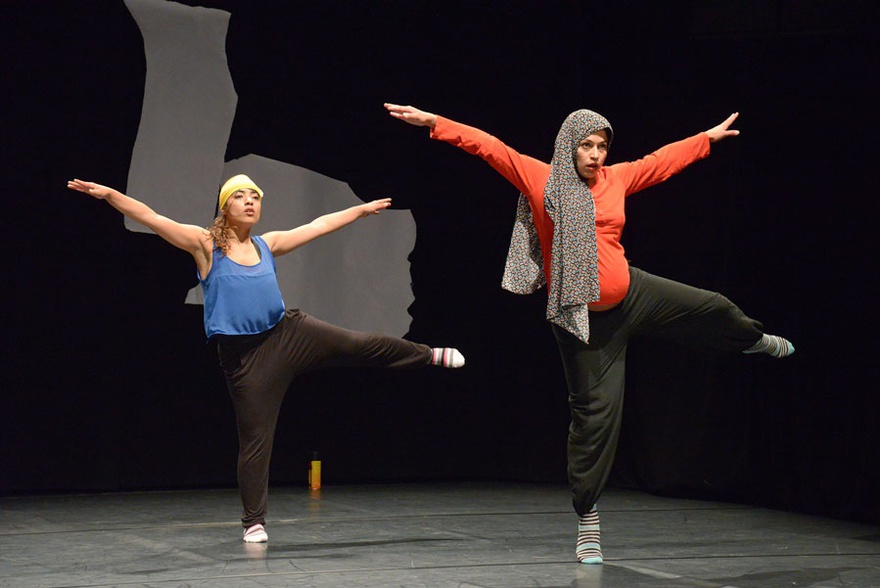Interviews
Speculations for Collective Transformations
Farah Saleh in conversation with Marianna Liosi
Archive material, testimonies and imagination are central elements in the practice of Palestinian choreographer and dancer Farah Saleh. Considering her body as an archive, Saleh reflects on a wide range of issues through her work, from education and dissent to obedience and refusal, as well as the growing Islamization of society, openness towards the other, the activism of the artist as well as of the viewer, and how art can drive people to imagine collective transformations. In one of her key pieces, the interactive video installation and performance A Fidayee Son in Moscow (2015), she portrays a day at the Interdom, an international boarding school in the Soviet Union built in 1933 in Ivanovo, north-east of Moscow, to host the children of revolutionary parents from all over the world – including those of leftist Palestinian leaders – as a form of solidarity between nations. This interview takes this piece as a starting point in order to explore how Saleh deals with viewer involvement in relation to technological mediation, and the relationship with and among spectators within a performative space.
Marianna Liosi: You started dancing when you were seven years old. Why?
Farah Saleh: Ever since I was a child, dance has always been my main form of expression.
ML: What form of dance did you begin with?
FS: I started dancing ballet in Amman until the age of eleven. Then, I moved with my family to Palestine. In Ramallah there was no ballet at the time. I tried dabke (a traditional Arab dance) for a while, but I couldn't relate to the staged form of it. I enjoyed much more dancing it in its improvised form at weddings and birthday parties. And so, I concentrated more on theatre and music (that I was already doing in Jordan) until the age of fourteen, until I found a ballet class at the Popular Arts Centre. When I turned sixteen I began contemporary dance with Nicholas Rowe in the same cultural centre and at Sareyyet Ramallah (a Palestinian civil organization providing its services for all social groups in the Palestinian society, including, among the others, a dance school). The reason for this switch to contemporary dance had to do with the possibilities offered by this genre, to express my inner nature and thoughts with pedestrian and uncodified movements and forms, which weren't conceivable with ballet or dabke.
ML: When you were eighteen you left Ramallah in order to start attending university in Italy. This was extremely common for young Palestinians. Especially in the 1970s and 1980s, when the Italian Communist Party in solidarity with the Palestinian cause guaranteed scholarships for students, but also later, during the First and the Second Intifada. However, you continued to practice contemporary dance while studying Linguistic and Cultural Mediation at The University for Foreigners of Siena, Italy. What connections do you see between your dance and academic background?
FS: There is a strong bond between my academic studies and my art practice because I've always attempted to mediate (socially and politically) between myself and the other, using the body as a tool.
ML: Referring to mediation, I'm interested in one of your most recent pieces:A Fidaye son in Moscow. This is a video installation divided into four chapters, each corresponding to a class – Creative Writing, History, Physics, Singing (although the latter video isn't yet public) – at the Interdom in Moscow. Using the setting of a classroom equipped with a desk and a blackboard, you speak from the video directly to the audience, like a teacher would to students during a class. Giving instructions to your scholars/audience, you encourage them to repeat the gestures that you make. You selected those four disciplines in order to connect to certain historical moments related to Palestinian events and to your own personal experiences. Can you tell me more about this, and how you constructed the choreography for each class?
FS: A Fidayee Son in Moscow, as well as Cells of Illegal Education (2016), which is a video-dance installation exploring gestures of civil disobedience made during the First Intifada, belong to what I call 'archive works'. These are pieces constructed through found material, testimonies and imagination.
In the case of A Fidayee Son in Moscow, most of the archive documents I discovered were about the physics, singing and sports classes at the Interdom. My brother attended that school for a year at the age of seven. He left home just after the war in Lebanon in 1982. At that time, many PLO members, Fidayeen, fled to other Arab countries. The political situation and the question of where to go was very unclear and uncertain, even for the Palestinian leadership, so some people, including my family, decided to send their children to the Interdom School. My brother only stayed there for a year, since the distance from home was too painful for my family and for him, too.
ML: What was it like for your brother at the Interdom?
FS: My brother doesn't like to speak about that time, as it wasn't an easy experience for him. But my mother remembered a lot about the institute and classes thanks to letters that he used to send from there, so I could imagine the experience and assemble the gestures. From his reports, education in the institute was strict. At the beginning, children from each country who couldn't speak Russian would attend classes in their own language, and then they participated in a few classes in the local language together. There were problems with food during those years: they couldn't get fresh fruit and vegetables because of the weather but also due to the Cold War. He felt alienated, there, but he also has some positive memories, like a beautiful green space where students could play.
Combining these testimonies and found materials with my imagination, I created the choreography for each class. The singing class, for instance, is about warming up the fingers and the left arm and then singing the Italian labour movement song 'Bandiera Rossa' (The Red Flag) together. The creative writing class is inspired by letters my brother sent to the family. The physics class mirrors the greatest Russian dream – to go to outer space. This was an important topic at that time, and the reason why, for many years, my brother wanted to be an astronaut.
ML: Each video in A Fidayee Son in Moscow starts with black and white found footage: the creative writing class starts with images from the Interdom school and a voiceover claiming that the Russian language unifies the students at the institute from all over the world. The physics class starts with joyful students learning through different tools with the help of a dedicated teacher. The history class seems to be an oral test on historical characters. These films look like propaganda excerpts produced by the school itself to acknowledge its educational methods as well as its international profile. Where did you find them?
FS: These extracts are exactly the archival material I was referring to. I discovered them on YouTube. They were mostly produced in the 1980s, while the footage in the newest video, the singing class, was filmed only a few years ago in the school – which is still open, mainly attended by Russian students, and now removed from its original communist vocation – on the occasion of its anniversary during a scholars' reunion.
ML: A Fidayee Son in Moscow began as a video installation and you've recently turned it into a live performance. How do you perceive the screen as a mediator between you and the viewer during the performance?
FS: My idea was to create the same situation in the installation and in the performance. Therefore the medium I use each time is only functional – to create that situation and to allow the audience to inhabit the Interdom. In the installation, I used the video as a medium, since I couldn't always be there physically to interact with spectators. Conversely, in the performance version, there was no need for the video, due to my actual presence.
ML: What relationship do you establish with the audience through the screen and vice versa?
FS: Each person enters the room in a different mood and in his own physical state. I try to take the interaction in a certain direction, but the outcome is uncertain – it's impossible to completely control it. What I'd like to convey is the encounter with the experience of studying at the Interdom and to make a historical comment in each class. Even if only for a short time, the audience can live the school's life, its mood, and this happens while performing gestures. Through repeating them, the physical and mental state of the viewer is affected.
ML: Do you see any difference in the audience's behaviour when viewing A Fidayee Son in Moscow as a live performance and the mediated version?
FS: Of course, I see a difference between the two. When I'm present I have more power, and I can exercise it. I give orders and I can make sure that people are taking them seriously and obeying them. I have the situation under control. Conversely, in the installation, the audience has more power and freedom to decide whether to follow my instructions or not.
In April 2016, I presented the work as a live performance for the first time in the U.S. It became an interactive lecture accompanied by three shorter videos. On this occasion, I could check the interactivity of the audience with the live work. There were around sixty people over two nights and they were all repeating the movements. For this version, I changed the classes a little bit, in particular the timing and spacing, and I introduced my live presence as well as the direct interactivity with objects, while keeping the same gestures. Of course, the inclusion of these elements generated different reactions in the spectators.
When the video installation was shown in London in January 2016 as part of the exhibition Suspended Account at The Mosaic Rooms, I saw that almost no one was accomplishing the gestures. Rather, they watched the videos many times and mostly analysed the choreography instead of trying it. I witnessed similar behaviour in Palestine, where few people physically responded. Viewers' reactions can be very different from one context to another.
ML: The gaze and how you 'choreograph' it play a crucial role in the video installation. Sometimes you look straight into the camera, sometimes at an undefined point. Is that to exert different levels of power on the viewer?
FS: I want spectators to understand that I see them somehow, that they're not alone, but with me. Sometimes I'm inciting them saying 'Yes, great job, excellent!' looking not into the camera, but suggesting that I'm addressing other students. When I direct my gaze into the camera, it's meant to exercise more authority. On the viewers' part, their reaction always depends on different variables, like their position in the space, whether they're sitting or standing etc. I tested the choreography of the gaze with my collaborators Zina Zarour and Sari Hammouri and chose solutions that we thought would give the best results.
ML: What individual and collective dynamics can the proximity of bodies potentially create in the performative space?
FS: Well, it depends a lot on how the work is installed. In Ramallah there were two desks in each room, so four people could sit at them and a few others could stand. The video was on a loop and the audience was free to circulate, some sitting, others leaving the room and generating a collective movement towards the corridor connecting the four classes. In this passage area, I attempted to recreate the aesthetic of the school, with pictures and blue paint on the walls, in order to make the audience live the experience of the school.
In London and also in the U.S, the work was installed only in one room. In both cases, people were sitting at the desks next to each other, and this position induced them to feel the pressure of staying still, interacting, watching the video again, or leaving. This proximity among bodies created a sort of community in the space. Nevertheless, an oppressive feeling could also be generated. During the opening, some people told me that the room was too packed and they wanted to come back alone. I understood that they felt the pressure of the public situation, which was forcing them to decide whether to interact or not. These comments are important feedback on the work.
ML: In most of your video installations and live performances, a series of instructions to the audience is one of the main structural elements. Sometimes they're given by voice, as in A Fidayee Son in Moscow, in others they're written on paper and affixed somewhere in the performative space. Why do you use these procedures?
FS: For me, giving instructions is mainly a mean for creating bodily and mental states in the viewer. For instance, in the performance Cells of Illegal Education, the instructions aim to convey the feelings of Palestinian students when facing the difficulties and obstacles that they have lived through during the First Intifada. The audience is invited to enter the room slowly, one by one, waiting for twenty seconds between one and the other. Then, people have to beware of their heads, they have to grab and eat a fruit while watching the video, and the last request is to leave from the backdoor rather then the main access from where they entered. According to testimonies and stories, this is what students daily had to do in order to secretly attend 'Popular Education', which was a new form of education that arose as a reaction to the shutting down of universities by Israel between 1987 and 1993. For me, asking people to follow instructions is a way to play with affect and make the audience experience someone else's feelings.
ML: The non-reaction, the refusal to respond physically, is also part of the performative gesture of the viewer and of his involvement in the work. How do you interpret this feedback?
FS: I often talk to those who don't try to do the movements. It's very intriguing for me when people don't obey orders. It's a way to protest against a regime, or in the case of A Fidayee Son in Moscow, it's a way to refuse the educational system I mean to recall. A person might just be intrigued by the process of teaching and wants to understand and observe more. Or one sometimes doesn't feel physically able to try these gestures. I always make an effort to understand the reason, but I've never interpreted it in a negative sense. Aside from the movements, I consider that people are already participating when they sit at the desk in the class and watch the videos, since the installation includes elements other than the gestures that allow the viewer to experience the Interdom School, such as pictures of Lenin and Svetlana Savitskaya (the first woman in space), the notes of 'Bandiera Rossa' hanging in the room, a piece of paper and a pencil to write with during the last class of the installation.
ML: In another performative piece, Free Advice (2015) you deal with the involvement of the viewer through a different model of gestures. The work unfolds in two phases: a research period that takes place in the public space, consisting of you standing in or walking along the street holding a huge 'Free Advice' sign made on cardboard and waiting for people to approach you and divulge their problems in search of answers or suggestions. Then, you transformed all the dialogues exchanged on the streets into movements and interactive dance actions with the audience in a more structured performative space. Can you tell us more about the process that you aimed to start with this piece and how the audience engaged with it?
FS: In Free Advice I looked for interaction with ordinary people, already during the creation period, to investigate my relationship – as an artist – with the society I live in. I went out on the streets of Ramallah, Vienna and Budapest with a 'Free Advice' sign to open a dialogue and exchange advice with passers-by. Then I brought all these collective concerns to the studio and transformed them into an interactive dance performance.
With this piece I mainly aim at tackling the social and political participation of artists and audience. So of course gestures are involved too, but people choose when and how to make them, as the piece is about pushing individuals to make decisions and not to be passive in their society. Free Advice is an invitation to look at our daily concerns, such as, for instance, finding a better job, happiness, love, freedom, emancipation, and so on, as a collective rather than as individuals. Once that is established, we can start acting for ourselves, but also for others.
ML: In July 2016 you presented the new production La Même at the Palest' In& Out Festival, Paris, for which you were awarded the dance prize. Together with Salma Ataya, who is also a dancer in the Sareyyet Ramallah Dance Company, you go through a process of progressive dressing up with different typologies of veil, that eventually almost completely cover your bodies. Short dialogues' intermissions and a soundtrack mixing different music genres – hip-hop and opera – are brought together with repetitive movements rhythm within the choreography. In this work you invite us to reflect on our glance itself, which observes, interprets and categorizes. Can you tell me more about how this piece was conceived and the reactions that it caused?
FS: The duet with Salma Ataya reflects on the tension between representation and reality of women wearing the hijab, niqab or burka in the western world and within secular communities in the Arab world. It invites the audience to look behind this cloth, while living an experience with two veiled and unveiled women during the performance acting in an analogous matter and having similar hopes, dreams, fears and proposing solutions for their concerns and problems. The question is open for the audience to answer. We are not making a statement for or against the veil. We're just asking the spectators to reflect through their experience of watching the performance upon whether women truly disappear or not behind a garment.
Nevertheless, we are also not hiding in this piece a growing Islamization of our society that we don't approve of, that's why the audience sees both dancers slowly being completely covered with clothes. La Même is also conceived for veiled women to come and see, and embody the performance, in order for them to think over their similarities with – and differences from – those who are not wearing this cloth. The work aims to be a space of reflection and maybe also of encounter.
ML: What effects do you imagine it will have if shown in Arab countries?
FS: We presented the piece in Ramallah in August 2016 for a small group of secular spectators and the reaction was the request for a clear statement, which is not what the piece is about. We might present it for a wider audience in Ramallah, Bethlehem and Jerusalem in April 2017 as part of the Ramallah Contemporary Dance Festival, and we'll have some more responses then.
ML: You've said several times that the archive is a fundamental source for your work. In particular, you consider the body as such a collection of images, memories, stories. How do you facilitate access for viewers to this plethora of information, feelings and emotions, and how do they make their own archive accessible to them?
FS: Considering my body as an archive, I feel I can create an access door for viewers by deconstructing movements. From this perspective, I can teach, demonstrate, and construct new gestures with viewers. This process represents the exposure of my archive, namely my body, to them. I get feedback when I see them accomplishing the gestures, or at least feeling or remembering them. Even when they don't try them physically, their bodies remember, since it's not only a matter of muscles but also of mental memory.
Of course, in the live performance when everyone reacts physically, I feel that I'm able to convey my archive to their bodies, and that they can absorb it through repeating and appropriating the gestures. Thanks to this process, this individual and group collection grows from one person to another, as well as all the invisible stories and movements behind them.
ML: What meaning and value does your work carry in the local context and in relation to the political situation in Palestine? Are there specific pieces that have raised a wider discussion within and/or outside the performative field?
FS: The purpose of all of my pieces is to open up discussion about social and political issues. In this sense I believe that all of my work has produced the expected result in a way, but I can't quantify the effectiveness of each piece. In A Fidayee Son in Moscow, the main subject was what happened to the children of the Palestinian Left and the Left movement in general. In Cells of Illegal Education, I aimed to focus on the Palestinians' means of civil disobedience used in the past and on how we can learn from them in today's struggle. In Free Advice, I wanted to question the role of the artist-activist in social and political change. In La Même, I invited reflection on whether we are annihilated as women because of a piece of cloth worn or unworn.
ML: All the narrative strategies you adopt in your performances refer to embodiment as a means to make us reflect upon our political activism as viewers and the multiple ways to express it. Do you think the development of performative arts in Palestine could affect social/political changes capable of improving the current situation?
FS: Yes, I think art can make a change, but in order for that to happen I believe the pool of art/dance students, artists as well as audiences, needs to grow. Art facilitates work on the individual and on his/her perception of the self and the other that definitely strengthens them and opens up their horizons in life. This is exactly what is needed here in Palestine at the moment: strong people who understand current problems and are able to find creative solutions towards building a progressive and change-driven society.
ML: Can you give an insight into the development of performance in Palestine, where you've been working for years, compared to the visual arts?
FS: The visual art scene in Palestine is much more evolved than the performing arts scene. The latter has been growing a lot, but it opened up to contemporary dance only in 2005, when it started trying to emancipate itself from dabke. The reason for this specific development I think is related to Palestinian history, context and cause. Visual arts, dance and theatre have accompanied the Palestinian Liberation Movement from the beginning. Political parties have involved visual artists and writers in the creation of posters and manifestos, so for them it was possible to explore away from traditional aesthetics while adhering to a political agenda. Conversely, it has been very important to stick to dabke as part of a wider process of the preservation of Palestinian land and identity, so for this reason it has been very difficult to experiment.
After the Oslo Accords in 1993 and 1995, artists from all artistic backgrounds understood that they could experiment. In dance, dabke became a little bit more innovative and contemporary through the integration of new movements of hands, jumps and so on. Some years later, in early 2000, workshops with international contemporary dancers began, and the scene has slowly grown with small presentations by Palestinian dancers. In 2006 the Ramallah Contemporary Dance Festival was launched. This opened the Palestinian scene to a wider network: many international companies came to perform and teach. Co-productions started and dancers studying all over the world started going back and forth, sharing what they'd learnt. The context is very vibrant today and it wavers between traditional dance and more experimental works.
ML: Can you imagine the future of performance in the region? And in relation to this, if you reflect on your role and practice, what agency do you feel you have as a performer and dancer in Palestine?
FS: After the Second Intifada, we knew – as artists and professionals – that many efforts were still needed on the ground, in the social and political sphere. Nevertheless, it seems that the Palestinian art scene in general has become very elitist and self-referential. That's why some years ago, I decided to intervene more in open spaces and off stage. I wanted to be more active in the streets and less in the studio or in galleries and to engage with installations and works that involved a wider interactivity with people. Many other artists are also working in the same direction in their own way. I want to be active from within in order to contribute to, and generate, some shift away from the endless political and social status quo.
Farah Saleh is a Palestinian dancer and choreographer active in Palestine, Europe and the U.S. She has studied Linguistic and Cultural Mediation at The University for Foreigners of Siena, Italy and in parallel continued her studies in contemporary dance. She has been dancing and choreographing with Sareyyet Ramallah Dance Company since 2010, for which she recently created Ordinary Madness (2013) and Hana and I (2014). She also took part in and toured internationally with Keffiyeh/made in China (2012) and Badke (2013) co-produced by the Royal Flemish Theatre (KVS), A.M Qattan Foundation and Les Ballets C de la B. Saleh has also been teaching dance, coordinating and curating artistic projects since 2010 with the Palestinian Circus School, Sareyyet Ramallah and the Ramallah Contemporary Dance Festival. In 2014 she won the third prize of the Young Artist of the Year Award (YAYA) for her installation A Fidayee Son in Moscow and in 2016 she won the dance prize of Palest'In and Out Festival in Paris for the duet La Même. She is currently touring with her latest pieces Free Advice (2015), La Même (2016) Cells of Illegal Education (2016).

